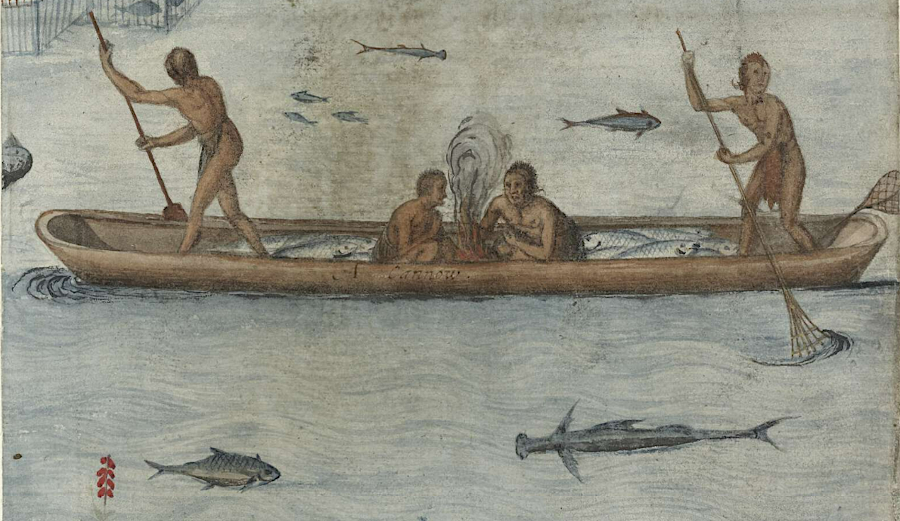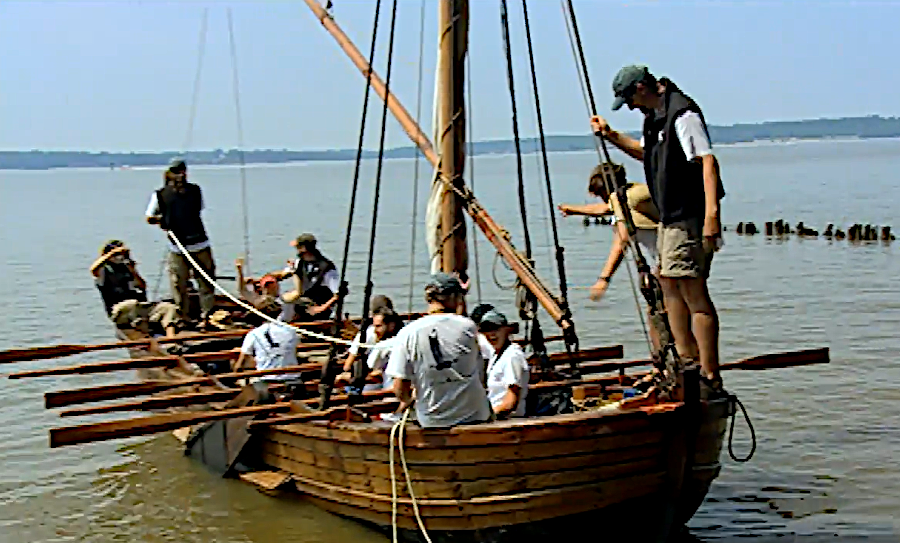
human muscle power moved canoes across the water
Source: British Museum, Alternative Fueling Station Locator (drawn by John White, 1585-1593)

human muscle power moved canoes across the water
Source: British Museum, Alternative Fueling Station Locator (drawn by John White, 1585-1593)
The first humans to reach Virginia walked here, carrying everything they owned on their bodies. Human muscles were essential for transporting food, tools, shelter, clothing, and other items needed by the Paleo-Indians to survive.
The original inhabitants descended from people who had boated over 20,000 years ago along the Pacific Ocean coastline to bypass the glacial ice. Odds are good that the people who ultimately reached the Atlantic Ocean had retained skills in building and paddling watercraft, as they crossed many streams and the wide Mississippi River.
Most likely, the expertise required to build boats from Arctic skins had evolved over time to utilizing fire and sharp stones to manufacture canoes from tree trunks. Muscle power remained the source of transportation energy until Europeans arrived in sailing ships.
When Europeans arrived in Virginia, they discovered Native Americans were skilled at manufacturing and using canoes for travel on rivers. The sailing ships of the colonists were a substantial improvement, but still limited to navigable rivers. Later, rafts and then canals enhanced the capacity to carry cargo, but overland transportation remained the domain of the horse-and-wagon until the 1830's in Virginia.
The initial capacity of a human to carry weight was dramatically enhanced when Europeans also introduced the domesticated horse. until the first explorers from Europe brought horses, the Native Americans in Virginia had no horses
The horse had originally evolved in North America, but died out before humans arrived on the continent. Cowboy movies of the mid-20th Century show that Native Americans adapted to the horse and became skilled riders. The need for grass, hay, and grain to feed horses and mules (for plowing fields) helped create the pattern of Virginia's farming landscape, with extensive pastures for feeding animals in addition to intensively-farmed cropland to feed humans.
A horse could pull one wagon. Up to eight horses could be harnessed together to pull a heavy wagon, especially if the road had been improved with a stone surface to minimize the mud... but beyond 8-horsepower transportation, new technology was required. In Virginia, the horse's first competition was not the automobile but the locomotive.
The earliest Virginia locomotives used firewood as their energy source, until after the Civil War. Wood was cut and stacked along railroad routes by contractors, and firemen in the locomotives shoved wood into boilers to burn, creating steam. Coal had more energy per pound, but wood was cheap and available everywhere...
Starting in 1748, coal was mined in the Triassic basin southwest of Richmond. However, coal remained a minor energy source in Virginia until after the Civil War. Over the next century, factories in Richmond did not migrate to the coal fields south of the city at Midlothian, or west of the city above the Fall Line. Factories continued to be concentrated at the Fall Line, and coal was shipped to the factories.
Railroads were finally built into the coalfields of Tazewell County and the Appalachian Plateau in the 1880's, after Northern industrialists figured out how to invest in Virginia, West Virginia, and Kentucky. Major coal production in Virginia started with the opening of the Pocahontas Mine in Tazewell County. Demand for that coal was so obvious that coal was produced and stockpiled in advance of the extension of the railroad to reach the mine.
The improved transportation technology stimulated large-scale commercialization of the coal resource, and coal-fired steam locomotive dominated American railroads until diesels were adopted in the 1950's. Coal also became the primary fuel for electricity generation, surpassing waterpower.
Wherever coal was produced on the Appalachian Plateau, the economy in isolated valleys was transformed from subsistence farming to a cash economy based on production at the mine. When the local labor force was fully employed, the mining companies imported new groups of laborers and built company towns in the hills, such as Clinchco (Dickenson County) and Dante (Russell County).
Those company towns have declined as the use of oil has increased. After World War Two, the Federal government's investment in building "freeways" shifted transportation away from rail and towards trucks/cars. In the 1950's, the Norfolk and Western Railroad (based on Roanoke) became the last major North American railroad to shift from coal to diesel.
Efforts to bring back coal-fired transportation, after the initial energy crises of the 1970's, demonstrated once again that compared to oil, steam technology for transportation requires too many moving parts, too much maintenance, and too much weight. Coal has too little lower energy/pound (can you imagine an airplane where jet engines were fueled by coal?). For transportation, coal is just a historical energy source.
Oil may also become a historical source, but that day is in the future. For now, transportation in Virginia is based on water at a few port cities, and upon oil for nearly every other location in the state.

a re-creation of John Smith's 1608 travels in a shallop included sails for windpower as well as muscle-powered oars
Source: Maryland Public Television, On the Trail of Captain John Smith: Rediscovering the Chesapeake Bay